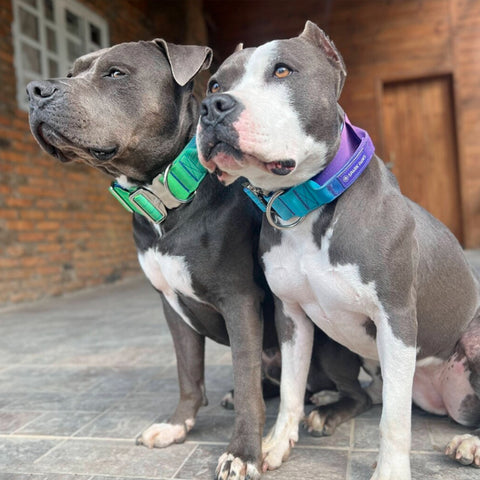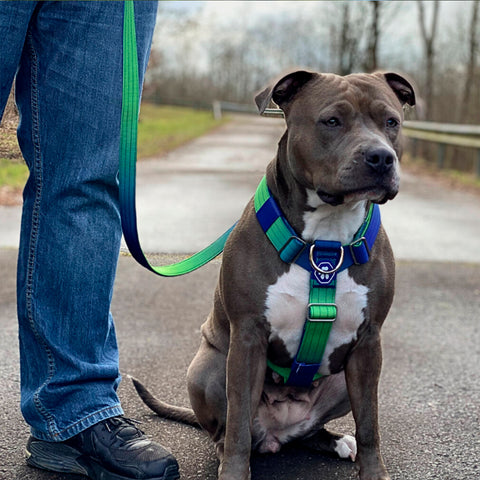Training A Pitbull Puppy: Expert Tips for a Well-Behaved Pooch
Pitbull puppies, specially the American pit bull terrier, are adorable, energetic little bundles of joy with a reputation for being strong-willed and sometimes challenging to manage. However, with the right approach and dedication, training your Pitbull puppy can lead to a rewarding experience and a well-adjusted, obedient adult dog. Let's take a deep dive into expert tips and strategies for raising a well-behaved pit bull pup.

Sparkpaws Dog Jewelry Charm Tag
What You Should Know Before Training Your Pitbull Puppy
Before you start the training journey with your pitbull puppy, there are several important considerations to keep in mind to ensure you are setting up for success:
Firstly, know your breeder. The temperament of your pitbull puppy is significantly influenced by its early breeding conditions. It's imperative to find a breeder who prioritizes breeding for good temperament and suitability as family pets, as opposed to breeding for aggression or guard dog capabilities. If you find out a breeder focuses on training guard dogs, it might be best to look for another breeder who has a strong track record of breeding friendly and sociable pit bulls.
Additionally, be proactive in doing your homework regarding the breeder's reputation, especially in relation to genetic health issues common to pit bulls, such as hip dysplasia or cataracts.
To gather this information, you can call previous owners, read reviews online, and consult with local animal shelters to learn more about the breeder's history and the health of their dogs. This due diligence can save you from future heartache and ensure that your new family member is as healthy as possible.
Understanding your pitbull's background, health, and temperament will provide you with valuable insights that will inform your training approach. Patience and consistency are key, as is the need for a firm but loving hand. Obedience training, employing positive reinforcement techniques such as clicker training, can be highly effective with this intelligent breed.
Remember, a well-informed dog owner is often better equipped to provide the right training and care, which translates to a happier, healthier pitbull puppy and a more fulfilling relationship between you and your new companion.
Start Socializing Your Puppy Early
Early socialization is crucial for any dog breed, and pit bulls are no exception. Introduce your young pitbull puppy to a variety of environments, other animals, and people to build their confidence and prevent any fear-based aggression. Socialization helps ensure your pup grows up to be an amiable and well adjusted dog.

Sparkpaws Tactical Dog Collars
- Bringing Your Puppy Home:
- Aim to bring your pitbull puppy home at 8 weeks of age.
- The period up to 16 weeks is crucial for social learning.
-
Interaction with the breeder introduces human contact and
early housebreaking. - Your role from 7 to 16 weeks is pivotal, especially for pit bulls.
- Settling In:
-
Give your puppy two weeks to adjust to your home before starting
major socialization. - Begin teaching basic commands and house-training.
- Pet your puppy often and encourage gentle handling by others.
- Meeting People:
- Have friends and family visit regularly, especially between 8 and 12 weeks.
- Early human interactions help the puppy see people as friendly.
- Introduction to Other Animals:
- Introduce your pitbull to other dogs and animals between 10 and 16 weeks.
- Opt for small parks or private spaces over dog parks for early social meets.
- Diverse Experiences:
- Take your dog on varied outings to expose it to different settings and stimuli.
-
Introduce your dog to cars, elevators, offices (where permitted), and
various homes. - Stay vigilant against health risks like parvovirus and ensure vaccinations are up to date.
- Regular Grooming:
- Brush and bathe your pitbull regularly, starting within the socialization period.
- As pit bulls require baths only monthly, early introduction to bathing is vital for future cooperation.
Teach Your Pit Bull to Behave Properly With Other Dogs
Dog parks and playdates are excellent opportunities for your pitbull to interact with other dogs. Monitor their playtime and set a positive tone, using positive reinforcement to encourage good behavior. Never force interactions, as this can lead to stress and potential conflicts.
When Should I Start Training My Pitbull?
The best time to start training is as soon as you bring your pit bull puppy home. At a young age, they are quick learners and can absorb basic commands such as sit, stay, and come. Starting early sets the stage for advanced training and dog sports pit bulls can excel in.
Leash Walking
Leash training is crucial for pit bull owners. A well-trained dog should walk calmly by your side without pulling. Leash corrections may be necessary initially, but always follow up with praise for good behavior. A Comfort Control No-Pull Dog Harness may greatly assist in this training.
Ensure safe and enjoyable walks with your pitbull puppy. Try the Comfort Control No-Pull Dog Harness today!
 Sparkpaws Activewear Walk Collection
Sparkpaws Activewear Walk Collection
Teach Through Advanced Training and Dog Sports
Pit bulls are athletic and often enjoy dog sports, which can provide excellent mental and physical exercise. Activities like weight pulling, agility, or obedience competitions can help channel their energy constructively.
Potty Training
Potty train your pitbull puppy from the outset by setting a strict schedule, supervising closely, and using cues to teach them where and when to relieve themselves. Remember, patience is key and rewarding your pup for going potty in the correct spot is essential.
Here are some tips to guide you through the process:
Setting up a designated potty area is essential, whether large or small, and guiding your pit bull to use this spot every time is crucial for successful potty training. Consistency in the location helps your puppy understand exactly where it's appropriate to relieve themselves.
In circumstances where your dog must learn to pee indoors, perhaps because you live in a high-rise apartment or have limited access to outdoor spaces, you can use special disposable training pads. Position these absorbent pads in the same spot each time to create a consistent last resort for your dog when you're unable to take them outside. It not only helps prevent accidents around the house but also provides your pitbull with a clear and designated potty area indoors.
Remember, timing and routine are everything. Take your puppy out regularly, especially after meals, naps, and play sessions. Praise and treats can be very effective in reinforcing good potty habits. If accidents happen, clean up calmly without punishment, as negative reactions can cause anxiety and confusion.
By maintaining patience and providing positive reinforcement, your pitbull puppy will soon learn where the right place to go is, leading to a well-trained, happy dog and a cleaner, more pleasant home for both of you.
Answering Your Pitbull Training FAQs
 Sparkpaws Comfort Control No-Pull Dog Harness
Sparkpaws Comfort Control No-Pull Dog Harness
Are Pit Bull puppies easy to train?
Pitbull puppies can be easy to train if you start at a young age with consistent, positive reinforcement-based methods. They respond well to a structured routine and clear expectations.
What is the right age to train a Pitbull?
The right age to start training is as soon as you bring your puppy home, usually around 8-10 weeks. Early training establishes a foundation for a well-behaved adult dog.
Should pitbulls be crate trained?
Yes, crate training can be a safe and effective way to potty train and prevent destructive behavior when you're not home. Ensure the crate is a positive space for your pup, filled with comfortable bedding and chew toys.
Use The Gradual Approach to Crate Training Your Pitbull
Training your pitbull to be comfortable in a crate can be approached in gradual, manageable steps. Initially, introduce your dog to the crate, allowing him to explore and become accustomed to it with the door open. Begin by placing your dog in the crate while you remain in the room. Spend about five minutes providing treats and praise, creating a positive association with the crate.
After this initial period, continue the process, but start introducing short intervals where you don't interact with your dog. This helps him learn that being calm in the crate can sometimes mean no immediate attention. Gradually increase the time to 10-minute sessions, extending it up to 30 minutes of calm behavior without direct interaction from you. It's important to reward him for staying quiet and settled during these times.
Once your pitbull is comfortable with a half-hour in the crate without your attention, start leaving the room for short periods. Begin with just 5 minutes and if he remains quiet, reward him as soon as you return to reinforce the desired behavior. Slowly extend the time you are out of the room, rewarding calm behavior consistently.
To make the crate even more of a safe haven, consider covering it with a blanket to create a cozy den-like atmosphere. Soft music or the sound of a television can provide a soothing background noise. Providing a safe bone or chew toy that he cannot choke on or swallow will also keep him occupied and help reduce any anxiety while he's alone.
Patience is key in crate training. With a compassionate and progressive approach, your pitbull will learn to see the crate as a personal space for relaxation and safety, making it an invaluable tool for potty training, transportation, and ensuring your dog has a familiar retreat no matter where life takes you both.
How do I train my Pit Bull puppy to protect me?
Training a dog to protect should only be done under the guidance of professional dog trainers, like those at Dog Training Elite and Dog Gone Problems or speak with your nearest veterinarian for a good dog trainer, to ensure it is done safely and responsibly.
Sometimes, an experienced hand can make all the difference. If you encounter any challenges while training your pitbull puppy, consider consulting with professional dog trainers. Dog Training Elite, specializes in working with pit bulls, providing services catered to their specific needs. Similarly, David Codr of Dog Gone Problems brings a wealth of experience to the table, particularly with behavior issues.
Conclusion: The Path to a Well-Trained Pitbull Puppy
Embracing these tips and incorporating key advice into your daily training routine can lead the way to a harmonious relationship with your pitbull puppy. Remember, every puppy is unique and requires a tailored approach to training. Stay consistent, use positive reinforcement, and don't shy away from seeking professional help if needed. Your dedication will pave the way for a lifetime of companionship with your well-trained pit bull.
With the right guidance, tools, and understanding, your journey with your pit bull will be filled with rewarding experiences as you watch your pup grow into a well-behaved and loving dog.
Don't forget to gear up for success. Elevate your pitbull's style and comfort - explore the Activewear Walk Collection now and step out in confidence with your well-trained pooch!
